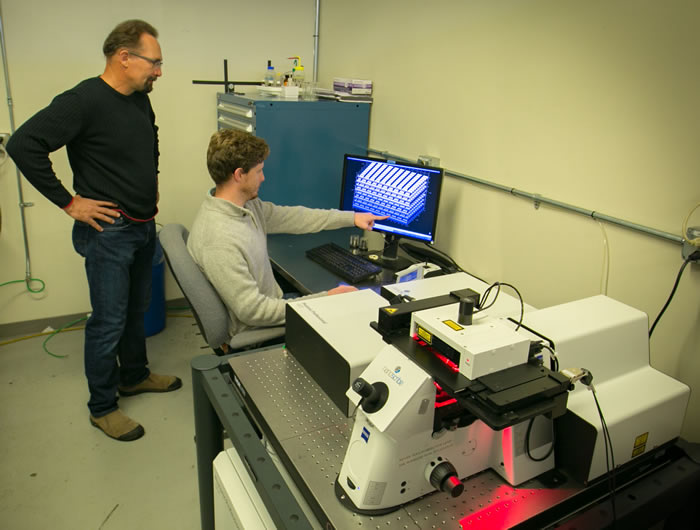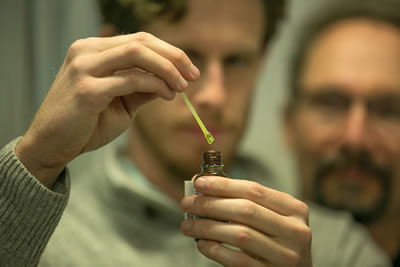Efficiency Improvements - 2016
October
3D Printing Can Speed Target Production
Producing target components for high-energy laser systems like NIF and the OMEGA laser at the University of Rochester is poised to take a big step forward in speed and flexibility, thanks to recent advances in 3D printing.
An additive manufacturing process called two-photon polymerization direct laser writing (2PP DLW) is enabling the fabrication of “on-demand” foam reservoir targets used to test how materials behave under extreme conditions.
Using the 2PP DLW process, a team of LLNL researchers led by Juergen Biener has fabricated the first millimeter-sized low-density foam reservoir targets with nanoscale features for material strength tests at OMEGA, becoming the first group to make precision macroscopic parts using the process. The research on OMEGA began in order to allow transferring the same technology to shots on NIF, where similar components are needed to improve the performance of future targets.
 James Oakdale (seated) and Juergen Biener examine a 3D printed foam reservoir target used to test how materials behave under extreme conditions. The control over fabrication inherent with 3D printing means researchers can easily change the target component’s properties, such as density, elasticity and brittleness. Credit: Julie Russell
James Oakdale (seated) and Juergen Biener examine a 3D printed foam reservoir target used to test how materials behave under extreme conditions. The control over fabrication inherent with 3D printing means researchers can easily change the target component’s properties, such as density, elasticity and brittleness. Credit: Julie Russell With the freedom to build in 3D space, LLNL postdoc James Oakdale has been able to fabricate these polymer foam target components in a matter of hours, instead of the weeks typically needed for traditional processes. The improved control over fabrication means researchers also can easily change the material’s properties, such as density, elasticity, and brittleness, from one build to the next.
“When something in target fabrication goes wrong, it could take us two months to replace it,” Biener said. “Now we can do it the next day or even overnight. The advantage is a shortcut in the time it takes to develop a new target component from conception to delivery. It opens the door to making things you couldn’t make before using traditional manufacturing.”
 James Oakdale holds the resin used for two-photon stereolithography-based 3D printing as Juergen Biener looks on. The process uses laser light to spatially convert a liquid mixture of photo-responsive monomers (the green substance in the photo) into solid, crosslinked acrylic material. The light source is a focused femtosecond-pulsed 780-nanometer laser. The resin has a green fluorescence because it contains a photoinitiator optimized for two-photon absorption, which occurs at one-half the input wavelength of the light. Credit: Julie Russell
James Oakdale holds the resin used for two-photon stereolithography-based 3D printing as Juergen Biener looks on. The process uses laser light to spatially convert a liquid mixture of photo-responsive monomers (the green substance in the photo) into solid, crosslinked acrylic material. The light source is a focused femtosecond-pulsed 780-nanometer laser. The resin has a green fluorescence because it contains a photoinitiator optimized for two-photon absorption, which occurs at one-half the input wavelength of the light. Credit: Julie Russell Material strength tests with high-powered laser systems such as NIF and OMEGA are used to validate existing computer models of material behavior under intense pressure. Biener said the 2PP DLW technique also can be used to develop material libraries for high-throughput “shotgun” experiments in which each library consists of hundreds of materials, each slightly different in feature size and other properties.
The on-demand capability of 3D printing is attractive for NIF, according to LLNL Targets Science & Technology Group Leader Michael Stadermann, and could reduce lead times for future experiments. While there are limits on which materials can be used as inks, Stadermann said, researchers are beginning to see the potential for faster, cheaper, and more reproducible fabrication methods not possible though traditional manufacturing.
“It’s easier to control what you’re testing, and you don’t have to do any machining after,” Stadermann said. “Being able to write something in the final shape you want is a real advantage, especially since many of the materials cannot be machined.”
Ultimately, researchers might see a cost benefit by using 3D printing for target production, Stadermann said. In the near term, researchers hope the greater flexibility and responsiveness only achievable through 3D printing can help them meet the demands of new physics.
The Laboratory Directed Research and Development (LDRD) program is funding the research. Along with Biener and Oakdale, members of the LLNL team are Will Smith, Jianchao Ye, Patrick Campbell, Marcus Worsley, Monika Biener, Sung Ho Kim, Swetha Chandrasekaran, Trevor Willey, Ted Baumann, Ray Smith, and Peter Amendt. The Lab’s Additive Manufacturing initiative is led by Chris Spadaccini.



